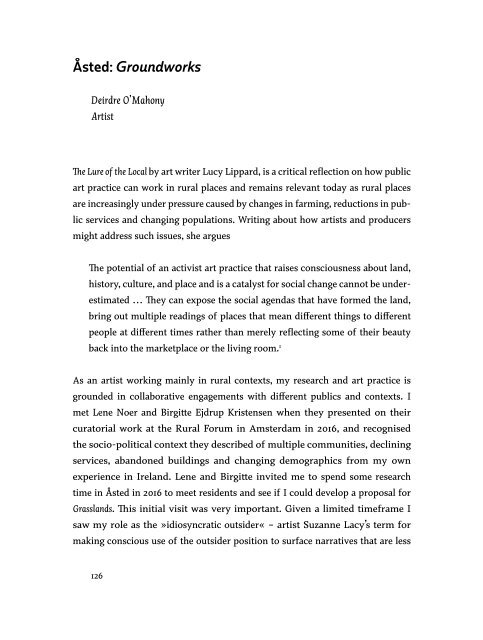Grasslands (eng)
GRASSLANDS has a sharp focus on Danish rural areas, and attempt to contribute to a more nuanced and qualified debate on rural development, through art projects.
GRASSLANDS has a sharp focus on Danish rural areas, and attempt to contribute to a more nuanced and qualified debate on rural development, through art projects.
You also want an ePaper? Increase the reach of your titles
YUMPU automatically turns print PDFs into web optimized ePapers that Google loves.
Åsted: Groundworks<br />
Deirdre O’Mahony<br />
Artist<br />
The Lure of the Local by art writer Lucy Lippard, is a critical reflection on how public<br />
art practice can work in rural places and remains relevant today as rural places<br />
are increasingly under pressure caused by changes in farming, reductions in public<br />
services and changing populations. Writing about how artists and producers<br />
might address such issues, she argues<br />
The potential of an activist art practice that raises consciousness about land,<br />
history, culture, and place and is a catalyst for social change cannot be underestimated<br />
… They can expose the social agendas that have formed the land,<br />
bring out multiple readings of places that mean different things to different<br />
people at different times rather than merely reflecting some of their beauty<br />
back into the marketplace or the living room. 1<br />
As an artist working mainly in rural contexts, my research and art practice is<br />
grounded in collaborative <strong>eng</strong>agements with different publics and contexts. I<br />
met Lene Noer and Birgitte Ejdrup Kristensen when they presented on their<br />
curatorial work at the Rural Forum in Amsterdam in 2016, and recognised<br />
the socio-political context they described of multiple communities, decli ning<br />
services, abandoned buildings and changing demographics from my own<br />
experience in Ireland. Lene and Birgitte invited me to spend some research<br />
time in Åsted in 2016 to meet residents and see if I could develop a proposal for<br />
<strong>Grasslands</strong>. This initial visit was very important. Given a limited timeframe I<br />
saw my role as the »idiosyncratic outsider« – artist Suzanne Lacy’s term for<br />
making conscious use of the outsider position to surface narratives that are less<br />
heard, or never heard. 2 In the context of Åsted, I was dependent on the curators<br />
and participants to guide the project and understand and prepare the ground and<br />
surface histories, narratives and positions that might offer ideas for the future<br />
of the village. Hospitality was offered, and coffee and cake consumed. It was<br />
very clear that many were anxious about the future, and one moment in the<br />
village’s recent history stood out, the closure and sale of the community hall.<br />
This is a large building that sits on the outskirts of the village with meeting<br />
rooms, a fully equipped kitchen and seating and tables for over a hundred<br />
people. After years of being managed and maintained by a voluntary local<br />
committee, a decision was made to sell it some years ago. Rather than see it<br />
demolished, an entrepreneur from Selde bought it for a very low sum and it<br />
is now rented out for events and parties. For me, this incident signified a kind<br />
of collapse of the collective wellbeing of Åsted – a withdrawal in the face of<br />
indifference towards a future that perhaps, presented too bleak a prospect<br />
to contemplate. Visiting some of those who looked after the space for many<br />
years, it was clear that this was a painful subject. One person, had carefully<br />
preserved scrapbooks containing the history of village life in the form of<br />
newspaper cuttings, photographs and documents which had been thrown out<br />
when the building was sold. I asked that these be scanned as in previous projects,<br />
I have used archives 3 as a catalyst to open up conversations about issues;<br />
whether social, economic or cultural, that have shaped the life of places.<br />
I put forward a proposal to make use of the archive to activate this reflective<br />
process which was accepted by the villagers. In January 2017 an open<br />
invitation was sent to all residents to take part in installing an archive in the<br />
126 127




